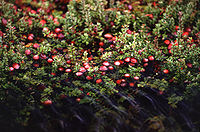
Photo from wikipedia
BACKGROUND Proanthocyanidins (PAC) are oligomers and polymers of flavan-3-ols with putative health benefits. PAC are prevalent in a wide variety of natural products and dietary supplements. OBJECTIVE An inter-laboratory study… Click to show full abstract
BACKGROUND Proanthocyanidins (PAC) are oligomers and polymers of flavan-3-ols with putative health benefits. PAC are prevalent in a wide variety of natural products and dietary supplements. OBJECTIVE An inter-laboratory study was conducted to validate the 4-(dimethylamino)cinnamaldehyde (DMAC) colorimetric assay using a 96-well plate spectrophotometer for the accurate quantification of PAC in cranberry products and to evaluate the comparison of the procyanidin A2 (ProA2) dimer and cranberry PAC (c-PAC) reference standards. METHODS Four test materials analyzed in this study included cranberry fiber powder, cranberry extract powder, concentrated cranberry juice, and a solution of cranberry PAC (30%, w/v). The samples were homogenized, extracted, sonicated, centrifuged, and analyzed using a 96-well plate spectrophotometer. RESULTS Linearity for both the ProA2 and c-PAC standards was determined from 4.053 to 50.666 µg/mL and from 13.520 to 135.95 µg/mL, respectively. The relative standard deviation of repeatability (RSDr) values for the four materials analyzed, using both ProA2 and c-PAC standards, met the Standard Method Performance Requirements (SMPR®). Inter-laboratory precision using Horwitz ratio (HorRat) values for the four materials analyzed, using both ProA2 and c-PAC standards, satisfies the acceptance range in Appendix K of the Official Methods of Analysis (2003): Guidelines for Dietary Supplements and Botanicals. The limit of quantification (LOQ) was estimated to be 3.16 µg/mL. CONCLUSIONS The results produced from this study demonstrate the utility of the c-PAC standard over the ProA2 standard and the advantages of using a 96-well plate spectrophotometer for the accurate quantification of PAC. HIGHLIGHTS The use of a 96-well plate reader and c-PAC reference standard in the DMAC method improves accuracy and percision for quantification of soluble proanthocyanidins in cranberry foods and dietary supplements.
Journal Title: Journal of AOAC International
Year Published: 2020
Link to full text (if available)
Share on Social Media: Sign Up to like & get
recommendations!